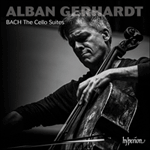‘Thoughtful, respectful, inspirational playing, a perfectly-placed recording, stimulating notes … this is a fine achievement’ (BBC Radio 3 CD Review)
‘Some of the best Bach playing I've heard since Casals’ (BBC Radio 3 CD Review)
‘This is the most wonderful cello-playing, surely among the most consistently beautiful to have been heard in this demanding music, as well as the most musically alert and vivid … few will fail to be charmed by Isserlis's sweetly singing tone, his perfectly voiced chords and superb control of articulation and dynamic—the way the final chord of the First Prelude dies away is spellbinding. There are so many other delights: the subtle comings and goings of the Third Prelude, the nobly poised Fifth Allemande, the swaggering climax into the Sixth Gigue—I cannot mention them all. Suffice to say that Isserlis's Bach is a major entrant into an already highly distinguished field, and a disc many will want to return to again and again’ (Gramophone)
‘His judicious ornaments sensitively decorate—never distort—Bach’s lines … rhythmically he’s impeccable. The free ‘phantasticus’ style of the first four Preludes is gloriously fluent, capturing the harmonic flow implied within the single cello line. The fifth, a French Overture, is free of bombast and its subsequent quasi-fugue lyrical and unhurried. Isserlis plays the sixth suite, intended for a five-string instrument, on a normal four-string cello, negotiating the stratospheric range with astonishing ease … his sense of style is matched by an outstandingly secure technique. He has no need for those impassioned tenutos behind which others hide the terrors of multiple-stopping … recording quality is excellent—two-channel stereo is all that’s required, and it’s excellently balanced between immediacy and spaciousness. Casals (re-issued on Naxos) started it all in 1936—Beamish’s Catalan folk-song arrangement is a charming tribute to him. Ter Linden (Harmonia Mundi) provides a fine period-instrument account, and Hugh (Kevin Mayhew) a somewhat reverberant but perceptive ‘modern’ option. But for me, Isserlis and Hyperion provide a completely new and inspiring benchmark for this unique tour de force’ (BBC Music Magazine)
‘This landmark recording combines bravura technique with scholartly research to produce a new interpretation … pushing each rhythmic possiblity to the limit but never sacrificing grace, charm and elegance’ (The Observer)
‘These are the cellist's Everest, and Isserlis has waited a long time to commit them to disc: his superb interpretations now put him in that great line of cellists that stretches back to Casals’ (The Independent)
‘Isserlis's dance-movements, particularly the jaunty Gigues, have a verve that is often missing from the 'classic' performances, and his Sarabandes, most of all the sublime 'Crucifixion' of No 5, are serene moments of repose and reflection in these thought-provoking and magnificently played accounts of these corner-stone works’ (International Record Review)
‘Isserlis is a passionate musician, but never thoughtless or frivolous, and the delicacy of his responses on this wonderful set sometimes take the breath away. If your soul fails to quiver in the quiet depths of the fifth suite’s sarabande, then you must be a robot in disguise. Yet he’s not on his knees always worshipping: time and again Isserlis asserts the music’s dance roots, whether through his thrusting accents or by sweeping through with a winning lilt … just listen to Isserlis, Bach and your heart, and the music that never dies’ (The Times)
‘A worthy successor to Casals in every way. He creates the satisfying sense of a musical journey through the Suites … Isserlis's interpretation treads the path between profound intellectual understanding and a sense of spontaeous expression, both qualities that the music requires … this is an outstanding recording of some of the greatest works of classical music and a disc that every music-lover should own’ (Classic FM Magazine)
‘His vibrato-light tone is soft-grained but seems infinitely malleable. He can dance with the grace of perfect strength and physique, and sing plaintively, or from the heart, or in celebration, as if it were the most natural thing in the world for him. In short, he's brought off that most remarkable of feats: making Bach's six great cello suites sound as if they might well have been written for him. This is unmissable music-making’ (The Irish Times)
‘These performances grab you with their intimacy and full-bodied embrace, their simple dedication and emotional truthfulness—an elusive juxtaposition of opposites that Isserlis captures better than most. You never sense he is playing for mood or effect—dynamic and expressive contrasts are modest—but he brings wonderful vigour and connectedness to the dance-like figurations. The sound makes you feel Isserlis is sitting four yards away, not just enjoying himself but also completely bound up in the technical and quasi-improvisatory challenges of Bach's world’ (Financial Times)
‘In a radically organic approach, Steven Isserlis takes the works back to their meditative core … the inner voice is on the whole wondrously refreshing, laced with flashes of wit and dazzling insight. I am still finding surprises on third hearing’ (The Evening Standard)
‘The Bach Cello Suites are the Everest to be conquered by every cellist, and the latest assault has been made by Steven Isserlis, with triumphant success … with this cellist's ability to catch exactly the rhythmic movements and contrast them with the steady beauty of the slow passages, this is a specially fine account’ (Liverpool Daily Post)
‘A beautiful, absorbing, must-have set of performances, with some delightful little add-ons, notably Sally Beamish's exquisite arrangement of a Catalan folk song, included by Isserlis as a homage to Pablo Casals. This will be a record of the year’ (The Herald)
‘This is the finest recording of Bach's cello suites that I've heard. The playing is enthralling, the production superb; nearly every detail sounds just right. Steven Isserlis has bided his time to record these suites and he comes to them with technique and sensibility finely honed, all of it evident in his richly dark tone, fluent phrasing, lithe dance rhythms and lovingly crafted lyricism … one of the year's outstanding recordings’ (Goldberg)

‘Staying true to the Baroque ideal of free instrumental expression, he stamps his own unconventional wisdom on these almost three-centuries-old standards. No two interpreters will ever agree on the Allemande in Suite No 2 … Isserlis, for his part, cuts loose with a rollicking, stylized jig that puts to bed the prior brooding Prelude. He teases out the individual personalities in each of the dances and trumpets them, molding each suite into a fuller, organic whole. Isserlis impeccably controls his slow movements, and his focused, restrained use of vibrato is perfectly in character’ (Time Out Chicago)
‘Steven Isserlis achieves the ideal synthesis between the old-fashioned approach to Bach's solo pieces and newer, supposedly more authentic notions. Listening to Mr. Isserlis, you may find yourself enjoying these six works more than you ever have before. His rhythmic élan is downright infectious, and he finds the heart of the music without getting maudlin. A clear first choice for these much-recorded suites’ (The Dallas Morning News)
‘These are … meticulously prepared accounts of a highly personal and reverent nature. Listeners will immediately warm to Isserlis’s genial way with the First Suite and the solemn majesty applied to the Third. And while Isserlis may have the sub-text, the suites work with or without that in mind. Steven Isserlis knows the detailed history of these suites, both in performance and in composition, and applies his years of research and familiarity without omission to disc. The project has clearly been a labour of love and comes across that way—a set of recordings made from compulsion, not duty’ (Classical Source)
‘It has taken him years to face up to the monumental challenge that is the Bach Cello Suites, but Steven Isserlis comes up trumps in a deeply intelligent traversal with a tremendous emotional pay-off’ (FirstPost.com)
‘Isserlis has done the impossible. He has given the listener something new, and indeed something outstandingly good … this recording can sit proudly on the shelf alongside the great recordings of Casals and Rostropovich. In fact, I may find myself picking it up as the favourite’ (bbc.co.uk)


 Bach: Cello Suites
Bach: Cello Suites Bach: The Cello Suites
Bach: The Cello Suites
